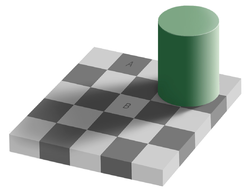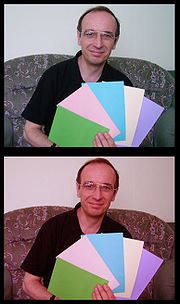
Color constancy
Encyclopedia



Subjective constancy
Subjective constancy or perceptual constancy is the perception of an object or quality as constant under changing conditions.-Vision:There are several types of perceptual constancies in Visual perception:-* Shape constancy* Size constancy...
and a feature of the human color perception system which ensures that the perceived color of objects remains relatively constant under varying illumination conditions. A green apple for instance looks green to us at midday, when the main illumination is white sunlight, and also at sunset, when the main illumination is red. This helps us identify objects.
Physiological basis
The physiological basis for color constancy is thought to involve specialized neurons in the primary visual cortex that compute local ratios of cone activity, which is the same calculation that Land's retinex algorithm uses to achieve color constancy. These specialized cells are called double-opponent cells because they compute both color opponency and spatial opponency. Double-opponent cells were first described by Nigel Daw in the goldfishGoldfish
The goldfish is a freshwater fish in the family Cyprinidae of order Cypriniformes. It was one of the earliest fish to be domesticated, and is one of the most commonly kept aquarium fish....
retina. There was considerable debate about the existence of these cells in the primate visual system; their existence was eventually proven using reverse-correlation receptive field
Receptive field
The receptive field of a sensory neuron is a region of space in which the presence of a stimulus will alter the firing of that neuron. Receptive fields have been identified for neurons of the auditory system, the somatosensory system, and the visual system....
mapping and special stimuli that selectively activate single cone classes at a time, so-called "cone-isolating" stimuli.
Color constancy works only if the incident illumination contains a range of wavelengths. The different cone cell
Cone cell
Cone cells, or cones, are photoreceptor cells in the retina of the eye that are responsible for color vision; they function best in relatively bright light, as opposed to rod cells that work better in dim light. If the retina is exposed to an intense visual stimulus, a negative afterimage will be...
s of the eye
Human eye
The human eye is an organ which reacts to light for several purposes. As a conscious sense organ, the eye allows vision. Rod and cone cells in the retina allow conscious light perception and vision including color differentiation and the perception of depth...
register different ranges of wavelengths of the light reflected by every object in the scene. From this information, the visual system attempts to determine the approximate composition of the illuminating light. This illumination is then discounted in order to obtain the object's "true color" or reflectance: the wavelengths of light the object reflects. This reflectance then largely determines the perceived color.
Retinex Theory
The effect was described in 1971 by Edwin H. LandEdwin H. Land
Edwin Herbert Land was an American scientist and inventor, best known as the co-founder of the Polaroid Corporation. Among other things, he invented inexpensive filters for polarizing light, a practical system of in-camera instant photography, and his retinex theory of color vision...
, who formulated "retinex theory" to explain it. The word "retinex" is a portmanteau formed from "retina
Retina
The vertebrate retina is a light-sensitive tissue lining the inner surface of the eye. The optics of the eye create an image of the visual world on the retina, which serves much the same function as the film in a camera. Light striking the retina initiates a cascade of chemical and electrical...
" and "cortex
Cerebral cortex
The cerebral cortex is a sheet of neural tissue that is outermost to the cerebrum of the mammalian brain. It plays a key role in memory, attention, perceptual awareness, thought, language, and consciousness. It is constituted of up to six horizontal layers, each of which has a different...
", suggesting that both the eye and the brain are involved in the processing.
The effect can be experimentally demonstrated as follows. A display called a "Mondrian" (after Piet Mondrian
Piet Mondrian
Pieter Cornelis "Piet" Mondriaan, after 1906 Mondrian , was a Dutch painter.He was an important contributor to the De Stijl art movement and group, which was founded by Theo van Doesburg. He evolved a non-representational form which he termed Neo-Plasticism...
whose paintings are similar) consisting of numerous colored patches is shown to a person. The display is illuminated by three white lights, one projected through a red filter, one projected through a green filter, and one projected through a blue filter. The person is asked to adjust the intensity of the lights so that a particular patch in the display appears white. The experimenter then measures the intensities of red, green, and blue light reflected from this white-appearing patch. Then the experimenter asks the person to identify the color of a neighboring patch, which, for example, appears green. Then the experimenter adjusts the lights so that the intensities of red, blue, and green light reflected from the green patch are the same as were originally measured from the white patch. The person shows color constancy in that the green patch continues to appear green, the white patch continues to appear white, and all the remaining patches continue to have their original colors.
Color constancy is a desirable feature of computer vision
Computer vision
Computer vision is a field that includes methods for acquiring, processing, analysing, and understanding images and, in general, high-dimensional data from the real world in order to produce numerical or symbolic information, e.g., in the forms of decisions...
, and many algorithms have been developed for this purpose. These include several retinex algorithms. These algorithms receive as input the red/green/blue values of each pixel
Pixel
In digital imaging, a pixel, or pel, is a single point in a raster image, or the smallest addressable screen element in a display device; it is the smallest unit of picture that can be represented or controlled....
of the image and attempt to estimate the reflectances of each point. One such algorithm operates as follows: the maximal red value rmax of all pixels is determined, and also the maximal green value gmax and the maximal blue value bmax. Assuming that the scene contains objects which reflect all red light, and (other) objects which reflect all green light and still others which reflect all blue light, one can then deduce that the illuminating light source is described by (rmax, gmax, bmax). For each pixel with values (r, g, b) its reflectance is estimated as (r/rmax, g/gmax, b/bmax). The original retinex algorithm proposed by Land and McCann uses a localized version of this principle.
Although retinex models are still widely used in computer vision, they have been shown not to accurately model human color perception.
See also
- Chromatic adaptationChromatic adaptationChromatic adaptation is one aspect of vision that may fool someone into observing a color-based optical illusion, such as the same color illusion.An object may be viewed under various conditions. For example, it may be illuminated by sunlight, the light of a fire, or a harsh electric light...
- Subjective constancySubjective constancySubjective constancy or perceptual constancy is the perception of an object or quality as constant under changing conditions.-Vision:There are several types of perceptual constancies in Visual perception:-* Shape constancy* Size constancy...
- Shadow and highlight enhancementShadow and highlight enhancementShadow and highlight enhancement refers to an image processing technique to correct exposure.The use of this technique is becoming more and more popular, making its way onto magazine covers, digital media, and photos...
Retinex
Here "Reprinted in McCann" refers to McCann, M., ed. 1993. Edwin H. LandEdwin H. Land
Edwin Herbert Land was an American scientist and inventor, best known as the co-founder of the Polaroid Corporation. Among other things, he invented inexpensive filters for polarizing light, a practical system of in-camera instant photography, and his retinex theory of color vision...
's Essays. Springfield, Va.: Society for Imaging Science and Technology.
- (1964) "The retinex" Am. Sci. 52(2): 247-64. Reprinted in McCann, vol. III, pp. 53–60. Based on acceptance address for William Procter Prize for Scientific AchievementWilliam Procter Prize for Scientific AchievementThe William Procter Prize for Scientific Achievement is an award given by Sigma Xi, a scientific-research honor society. The Procter Prize is presented annually to a scientist who has made an outstanding contribution to scientific research and has demonstrated an ability to communicate the...
, Cleveland, Ohio, December 30, 1963.
- with L. C. Farney and M. M. Morse. (1971) "Solubilization by incipient development" Photogr. Sci. Eng. 15(1):4-20. Reprinted in McCann, vol. I, pp. 157–73. Based on lecture in Boston, June 13, 1968.
- with J. J. McCann. (1971) "Lightness and retinex theory" J. Opt. Soc. Am. 61(1):1-11. Reprinted in McCann, vol. III, pp. 73–84. Based on the Ives Medal lecture, October 13, 1967.
- (1974) "The retinex theory of colour vision" Proc. R. Inst. Gt. Brit. 47:23-58. Reprinted in McCann, vol. III, pp. 95–112. Based on Friday evening discourse, November 2, 1973.
- (1977) "The retinex theory of color vision" Sci. Am. 237:108-28. Reprinted in McCann, vol. III, pp. 125–42.
- with H. G. Rogers and V. K. Walworth. (1977) "One-step photography" In Neblette's Handbook of Photography and Reprography, Materials, Processes and Systems, 7th ed., J. M. Sturge, ed., pp. 259–330. New York: Reinhold. Reprinted in McCann, vol. I, pp. 205–63.
- (1978) "Our 'polar partnership' with the world around us: Discoveries about our mechanisms of perception are dissolving the imagined partition between mind and matter" Harv. Mag. 80:23-25. Reprinted in McCann, vol. III, pp. 151–54.
- with D. H. Hubel, M. S. Livingstone, S. H. Perry, and M. M. Burns. (1983) "Colour-generating interactions across the corpus callosum" Nature 303(5918):616-18. Reprinted in McCann, vol. III, pp. 155–58.
- (1983) "Recent advances in retinex theory and some implications for cortical computations: Color vision and the natural images" Proc. Natl. Acad. Sci. U. S. A. 80:5136-69. Reprinted in McCann, vol. III, pp. 159–66.
- (1986) "An alternative technique for the computation of the designator in the retinex theory of color vision" Proc. Natl. Acad. Sci. U. S. A. 83:3078-80.

